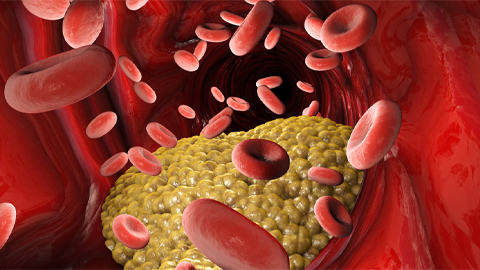From the journals: JLR
Do lipid levels influence mortality? Unraveling cholesterol biosynthesis. Phospholipids promote toxoplasmosis. Read about papers on these topics recently published in the Journal of Lipid Research.
Do lipid levels influence mortality?
Alterations in plasma lipids, or dyslipidemia, are a major risk factor for heart disease and mortality. This condition is defined as elevated plasma cholesterol, low-density lipoprotein cholesterol, or LDLor triglycerides and low plasma high-density lipoprotein cholesterol, or HDL-C. Because researchers don’t understand the relationship between lipid profiles and all-cause and cause-specific mortality, which define the number of deaths from any cause or from a specific cause, respectively, Jiawen Lu and Zhenqian Wang of Sun Yat-sen University and a group of researchers in China explored this association using a metanalysis.

In a recent article in the Journal of Lipid Research, the team conducted statistical tests on a population of 407,951 British individuals that probed the causal relationship between type of mortality and lipid levels. Of this population, 45.9% had cause-specific mortality. They examined the association of mortality with six traits: LDL-C, HDL-C, triglycerides, apolipoprotein A1, or ApoA1, apolipoprotein B, or ApoB, and lipoprotein(a), or Lp(a). The authors showed that individuals with high levels of ApoA1 are at decreased risk of all-cause mortality. In the case of cause-specific mortality, individuals with high ApoA1 levels are at decreased risk of cancer-related mortality. Furthermore, they showed that individuals with low Lp(a) levels have an increased risk of cardiovascular disease–related, or CVD, and digestive disease–related mortality. Finally, they found that ApoB levels are positively correlated with CVD-related and neurodegenerative disease–related mortality, while individuals with high levels of LDL-C are at increased risk of CVD-related mortality and decreased risk of neurodegenerative disease–related mortality.
These findings suggest that elevated ApoA1 levels and low Lp(a) levels may attenuate an individual’s risk of cancer and digestive disease–related death. Furthermore, modulating specific plasma lipid levels to mitigate risk may open a new avenue of personalized treatment.
Unraveling cholesterol biosynthesis
Impaired cholesterol metabolism can lead to elevated plasma lipid levels and cause cardiovascular disease, or CVD, neurodegenerative disease, cancers and other disorders. Therefore, scientists must identify the underlying genetic factors that control lipid biosynthesis and metabolism, which they do not yet completely understand.
In a recently published Journal of Lipid Research article, James A. Votava and collaborators from the University of Wisconsin–Madison identified novel genes that regulate cholesterol metabolism by analyzing existing mouse liver transcriptome and proteome datasets. They identified 36 conserved cholesterol biosynthetic genes, 32 of which directly regulate cholesterol metabolism, including retinol dehydrogenase 11, or Rdh11, ethylmalonyl-CoA decarboxylase 1, or Echdc1, and aldolaseC, or Aldoc. Their studies showed that Rdh11 knockdown significantly increased cellular cholesterol levels. In addition, they found that Echdc1 regulates plasma cholesterol and triglyceride levels. Genome-wide RNA sequencing data confirmed that both Rdh11 and Aldoc are correlated with liver cholesterol metabolism in humans.
Using mice lacking Aldoc, the authors found that this gene regulates plasma and hepatic cholesterol levels, triglyceride metabolism and cholesterol biosynthesis. Future studies will explore the publicly available genome-wide liver expression datasets to identify additional unknown genes involved in cholesterol metabolism that could be leveraged to treat genetic CVDs.
Phospholipids promote toxoplasmosis
Toxoplasma gondii is a widespread intracellular parasite that causes toxoplasmosis, a condition that can be fatal for immune-deficient people and lead to miscarriage and birth defects. Glycerophospholipids are the main lipid component of parasite membranes. However, researchers do not know how the parasite synthesizes some lipids, such as phosphatidylserine or PtdSer.
In a recently published Journal of Lipid Research article, Dimitrios Alexandros Katelas from the group of Nishith Gupta at the Birla Institute of Technology and Science Pilani, Hyderabad Campus, India, investigated how the parasite’s phospholipid pathway impacts T. gondii infection. They showed that PtdSer synthase, or PSS, in the parasite’s endoplasmic reticulum, produces PtdSer through a base-exchange-type mechanism using preexisting phospholipids. PSS also significantly contributed to the biogenesis of another similar glycerophospholipid, phosphatidylethanolamine or PtdEtn, via the lipid decarboxylation pathway. T. gondii mutants that lack PSS failed to grow in culture, demonstrating that PSS is required for the parasite to thrive in human host cells. As known, PtdSer and PtdEtn partly localize in the inner membrane complex or IMC, located under the plasma membrane of the parasite. IMC harbors a molecular motor machinery critical for the parasite locomotion. Notably, the PSS-deficient strain showed highly impaired parasite motility, which is attributed to the compromised integrity of IMC.
Future research will explore tools to determine the functional contribution and subcellular location of other phospholipids, such as phosphatidylthreonine or PtdThr, a structural analog of PtdSer. Small molecular inhibitors of parasite-specific enzymes contributing to glycerophospholipid synthesis may represent drugs for treating acute toxoplasmosis.
Enjoy reading ASBMB Today?
Become a member to receive the print edition four times a year and the digital edition monthly.
Learn moreGet the latest from ASBMB Today
Enter your email address, and we’ll send you a weekly email with recent articles, interviews and more.
Latest in Science
Science highlights or most popular articles

The science of staying strong
Muscles power every movement, but they also tell the story of aging itself. Scientists are uncovering how strength fades, why some species resist it and what lifestyle and molecular clues could help preserve muscle health for life.

Bacteriophage protein could make queso fresco safer
Researchers characterized the structure and function of PlyP100, a bacteriophage protein that shows promise as a food-safe antimicrobial for preventing Listeria monocytogenes growth in fresh cheeses.

Building the blueprint to block HIV
Wesley Sundquist will present his work on the HIV capsid and revolutionary drug, Lenacapavir, at the ASBMB Annual Meeting, March 7–10, in Maryland.

Gut microbes hijack cancer pathway in high-fat diets
Researchers at the Feinstein Institutes for Medical Research found that a high-fat diet increases ammonia-producing bacteria in the gut microbiome of mice, which in turn disrupts TGF-β signaling and promotes colorectal cancer.

Mapping fentanyl’s cellular footprint
Using a new imaging method, researchers at State University of New York at Buffalo traced fentanyl’s effects inside brain immune cells, revealing how the drug alters lipid droplets, pointing to new paths for addiction diagnostics.

Designing life’s building blocks with AI
Tanja Kortemme, a professor at the University of California, San Francisco, will discuss her research using computational biology to engineer proteins at the 2026 ASBMB Annual Meeting.

